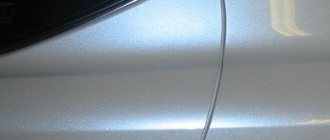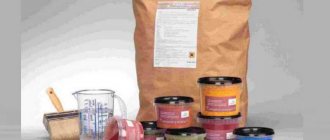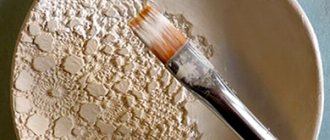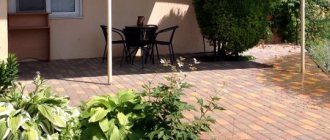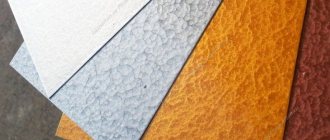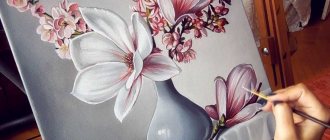Pearlescent paints for walls
This wall paint gives an interesting pearly shine and is suitable for painting many surfaces and even furniture elements. What component provides this shade?
What provides this shade?
The iridescent glow effect occurs due to the refraction of pearlescent light, which consists of glass and mica. Using natural mica, opaque mother-of-pearl is obtained. When using artificial it is translucent, and when using glass it is transparent.
- Pigments consist of microscopic granules or plates and have gloss and brightness. They are used to create visual depth.
- For a metallic shine, use aluminum or bronze powder.
- Particle size and application layer affect the shade.
- Pearl paint has three basic colors: gold, silver and pearl.
Relevance
Mother-of-pearl coating has a wide range of uses, used for interior decoration, furniture and decorative elements. It’s easy to create unique interiors, experiment and get effects with varying shine and shimmer with mother-of-pearl.
Application
The material is versatile and easy to use. It is applied for:
- wood;
- glass;
- concrete;
- drywall;
- DPS and other lumber.
Combinations
The material is compatible with many coatings:
- You can use any type of paint together: alkyd, oil or water-based;
- when covering wooden surfaces, it is better to add pigment to a wax or plaster mixture;
- When painting, ready-made solutions are used.
How to apply
The application process does not require special devices. You can work with the same tools that are used when painting with acrylic composition.
Sponge
Using a foam sponge it is convenient to create ornaments, designs and designs.
It is more suitable for decorating surfaces rather than for complete painting. The sponge is dipped into the composition and applied to the surface using pressure or circular movements. After each use, the sponge is freed from excess mixture by pressing on a sheet of paper or cardboard.
Brush
A brush is used to paint some elements or fragments. Mainly for decorative purposes. Fill the required space by touching the surface. You can use the technique of two round brushes with different shades of paint and apply simultaneously with chaotic movements.
Spray gun
A convenient way to apply paint with an even layer. The main thing when using a spray gun is to bring the paint to the consistency of sour cream.
Roller
It is convenient to work with a roller; it is the main tool. The coating applies evenly and economically. With it you can make clear boundaries. It is better to use a fur roller with thin, short pile. Apply the paint with straight or cross-shaped movements in two layers.
A rag roller creates the effect of “crumpled” walls. The rag must be dipped into the paint and squeezed out halfway, why twist it into a rope and wrap it around a roller, then paint the surface.
Brush
The brush is suitable for painting hard-to-reach places and corners.
But not for a large surface. Painting a large area with a brush is inconvenient, and more material is wasted.
A brush with soft bristles is suitable for dense coloring; a synthetic brush (for creating patterns) is applied with cross-shaped or straight movements.
Using a flat brush, apply stripes in different directions to achieve the desired result. Apply masking tape to the paint borders.
Putty knife
Using a spatula, paint is applied to the wet plaster using wave-like movements or making furrows, obtaining an original effect.
Metal pigments
Such pigments, when added to resin, give the effect of liquid metal and provide beautiful refraction. Most often, metal pigments are used not to completely fill the product, but to create a unique pattern.
The pigment is a fine powder, without any foreign additives. The gold pigment looks gorgeous, the color of which can be enhanced if you use a regular gas burner. To do this, place the burner at a distance of 15-20 centimeters under the pigment, and it will begin to float. Next, using a toothpick, you can make beautiful shimmering patterns on the surface of the product.
A composition with the addition of silver particles gives a similar effect. Powder with a bronze tint produces a resin with a uniform coloring reminiscent of copper. When mother-of-pearl is added to a metallic pigment, a hazy effect is obtained.
The main thing to remember is that the maximum permissible concentration of any pigment should not exceed 5%. This volume allows the epoxy resin to be completely opaque.
Craftswomen use metal pigments to create jewelry, decorative items, and paintings using the Resin Art technique.
View metallic pigments
How to do the work yourself
The very first thing to do is prepare the surface:
- it is necessary to check the walls for defects and curvature;
- If any defects are found, correct them: remove the old coating and putty the surface until smooth, knock off the old plaster, clean the protrusions;
- then remove dust and dirt and prime thoroughly;
- When the primer is dry, start painting.
To paint with pearlescent composition, follow the following procedure:
- stir the paint, can be diluted with water, no more than 15% of the total mass; The pearlescent composition can be tinted;
- with a narrow brush, apply a starting line under the baguettes, 5–10 cm wide. This is necessary for further work with a roller, so as not to stain the ceiling;
- Now you can apply the first layer - it is called the base or background. A velor roller is better suited for the job;
- Pour pearlescent paint into a painting tray and apply evenly to the surface using a roller;
- then leave everything until completely dry.
To create drawings and ornaments, you need to use tools, depending on the idea.
How to make a room pearly white
White color visually expands the space. Pearlescent white color is universal and suitable for apartment design.
But it should be borne in mind that this color emphasizes the unevenness and defects of the walls.
Therefore, you need to either properly prepare the surface, or choose walls that are smooth and without flaws.
For coating, you can use pearlescent paint or pearlescent plaster. The latter does not require perfect walls; with its help it is easy to hide imperfections. Application method is the same as with conventional paints.
If you need to apply a pattern, use a sponge, brush or stencils.
Chameleon effect
Apartment design with a chameleon effect is popular. It is created using the pigment of the same name, which is added to the paint and changes its color under different viewing angles. It looks brightest on a dark base.
This effect visually smoothes out unevenness and looks interesting on convex parts.
When applying, it is better to use a spray gun or airbrush.
Pink pearl
Mother-of-pearl paint with a pink pearl effect will add tenderness and romance to the interior.
Combines with many colors: white, gray, blue. “Dusty” shades are especially popular.
Application is just as easy.
Depending on the design, you can use a sponge, roller and other tools.
Classic white pearl
White pearls are suitable for the interior of a house or apartment. Noble shine and shimmer gives the interior chic and luxury.
Before applying, you need to prepare the surface, because this shade emphasizes unevenness and imperfections.
If desired, the design can be placed using a stencil or roller.
Paint is applied in the usual way.
Mother-of-pearl paints have a wide range of palettes; they can be used to create an imitation of velvet, velor, granite, sea surface, and silk.
In what form is it produced?
On construction markets, this pearlescent pigment can be purchased in the following forms:
- Powder. It is convenient because it can be added to any acrylic dye to create the desired color, creating a color palette and adjusting the degree of light reflection. The downside is that if the master does not have experience, the material may be diluted unevenly, and when mixed with water-based enamel, lumps may form.
- Paste. It is convenient for diluting with acrylic enamels, it allows you to get a large color palette for decoration and when mixed it gives a homogeneous mass. Minus - compared to powder, it does not have a very long shelf life.
- Ready-made enamel with pearlescent color. Very convenient for beginners or in cases where complex decorative finishing is not planned, but just needs to be painted on the walls or ceiling.
Acrylic enamels with the addition of pearlescent pigment after drying are very durable, resistant to environmental influences and do not require additional protection. They can be used as a finishing touch to the facade, to create various graffiti on fences, or to decorate the walls and ceilings of interior spaces.
A dye with a light-refracting effect has only a slight limitation regarding color: the color of gold can only be used for interior decoration; it quickly fades under direct exposure to ultraviolet radiation.
The silver color has increased durability and weather resistance, so it can be used with any coloring options.
Phosphors and fluorescent pigments
A phosphor is a self-luminous pigment in powder form that can absorb and accumulate ultraviolet rays. In the dark, it slowly releases its accumulated energy, creating a glow. The brightness of the glow depends on the concentration of the phosphor in the resin.
The pigment is completely safe for human health and is not toxic or even radioactive. The latter property is present in phosphorus, so its use has practically been abandoned. Sometimes phosphorus is also used to create street signs, but even there they are trying to do without it.
The powder must accumulate light for at least 8-10 hours, then it can delight with radiance from 5 to 12 hours. The product will emit the brightest light in the first hour and a half. Do not forget about this property of the pigment when choosing a specific area of its application.
Initially, the color range of phosphors was represented by a small number of shades: green, yellow-green and blue. And this choice of manufacturers is justified: they provide the most powerful glow. The most intense light is emitted by white phosphors. However, the popularity of phosphors with the addition of coloring pigments is growing and you can purchase options in orange, purple, pink and other colors. Note that luminous powder can be used together with sparkles (glitter), then the effect will be even more interesting.
To obtain a bright, saturated glow, the consumption is 1:4, that is, 4 parts of epoxy resin are taken for 1 part of the phosphor. If you need a soft diffused glow, then the proportion is already 1:8 (8 parts of epoxy resin are taken for 1 part of the phosphor). The brightness is also affected by the size of the phosphor particle fraction. For epoxy resin, it is recommended to take powder with a fraction size of 30 microns. It is porous, mixes well with the resin and practically does not precipitate.
Mixing the pigment with the resin is quite simple. Phosphor powder is added to the finished epoxy resin and mixed with a wooden or plastic stick. For large volumes, it is permissible to use a construction mixer at low speeds.
The addition of a phosphor does not affect the properties of the epoxy resin, so it can be used for absolutely any product. Interior items, jewelry, watch dials, and buttons look interesting. If you pour such a mixture onto a table top where the pattern has been burned out in advance, then the glow in the recesses will be as bright as possible, giving it a special attractiveness.
Phosphors should not be confused with fluorescent pigments for epoxy resin. They do not accumulate light energy and are not capable of emitting light on their own. However, fluorescent pigments produce powerful light when exposed to ultraviolet rays. Most often they have bright acidic shades, giving the product an original appearance.
Select luminous pigments
Decoration options
Depending on the concentration of pigment contained in acrylic enamel, two design options can be used.
Strong concentration
With a high concentration of pigment, the color of the paint plays a secondary role, giving only the necessary shade to the shiny surface. This dye is rarely used in large quantities: the ceiling or walls painted with it will become tiring with their bright light-refracting effect, and it will not be very comfortable to be in such a room.
Bright concentrated colors are used to highlight individual interior elements. You can purchase a highly concentrated composition ready-made, but it is much more convenient to make it yourself by adding powder or paste containing mother-of-pearl in the required quantity to the paint. Creating a color scheme yourself is convenient because you can create the concentration necessary to implement a design solution.
Weak concentration
With a small concentration of pigment, painting is carried out as with other acrylic dyes, and when designing, much attention is paid to the color selection. The ceiling or walls painted with this composition shimmer softly in different lighting conditions, creating a cozy atmosphere.
Mineral pigments
An interesting variety of pigments for epoxy resins, they are a finely ground composition with the addition of natural mineral components. Designed to create a monochrome color that is rich and noble. The fine fraction allows for excellent mixing with epoxy resin. Also, mineral pigments retain their original color for a long time and do not fade in the sun.
Just like other powdered pigments, they are simply added to the finished mixture and mixed until smooth.
All mineral pigments
What can you use to paint?
Like other paint compositions, acrylic enamel with mother-of-pearl effect can be applied to ceilings or walls using the following painting tools.
It is recommended to be used when it is necessary to paint small areas. For example, paint a hard-to-reach surface area, the junction of walls and ceilings, or draw individual decorative elements. It is not recommended to use a brush on large surfaces: painting will take a lot of time, and the consumption of coloring material will be large.
By applying the coloring composition using a regular foam sponge, you can get beautiful, unusual stains on the walls. The sponge is used as an additional means of decoration in interior design.
A convenient tool that allows you to quickly and evenly distribute the coloring composition over a large area. It is better to use fur rollers with short, thin pile. If decorative finishing is planned and only part of the wall needs to be painted, it is recommended to mark the painting area using masking tape - this will ensure quick and accurate work. After the paint has dried, the tape can be easily removed.
A modern painting tool that allows you to work quickly and economically. Before filling, it is recommended to dilute the coloring composition with water to the required fluidity, but the amount of added water should not exceed 40% of the total mass of the preparation. The desire to make the solution thinner can lead to the adhesive properties of the paint being disrupted and it will not adhere well to the ceiling or walls. In addition, the protective properties of the composition will decrease (if there were additional additives that protect the metal or wood from destruction).
Color with mother-of-pearl is applied to walls or other substrates in the same way as other paints with acrylic. The process consists of the following necessary steps:
- Clean surfaces from dirt and remnants of old decorative material. If possible, it is recommended to wash and dry the base for painting.
- Remove defects in the area to be painted (seal large cracks in wood, plaster potholes in concrete, etc.)
- Apply a primer suitable for the material and wait until it dries.
- Paint with the chosen painting device.
To achieve the ideal effect, regardless of the method of applying paint, it is recommended to paint in 2 layers.
There are many ways to get an original, unusual interior design solution. Designers advise beginning decorators to try the following design options:
- In a room with good lighting, apply the first layer of blue acrylic enamel to the wall without adding mother-of-pearl. After drying, apply a second layer with mother-of-pearl, but using a dye of a slightly different shade. When the rays are refracted, the surface will constantly change color, creating amazing color effects.
- You can revive a room painted in neutral colors in a very original way: cut out a template from thick paper that resembles a tree leaf, apply pearlescent paint to it and briefly apply it to the surface. These leaves can be arranged in any order, or you can draw a tree trunk and place them around.
With a little practice and imagination, you can create many more unusual, beautiful solutions for interior design.
Acrylic enamels with mother-of-pearl are easy to use, durable and relatively inexpensive. Their skillful use through a combination of color and light refractive effect will help to obtain an unusually beautiful result in design.
